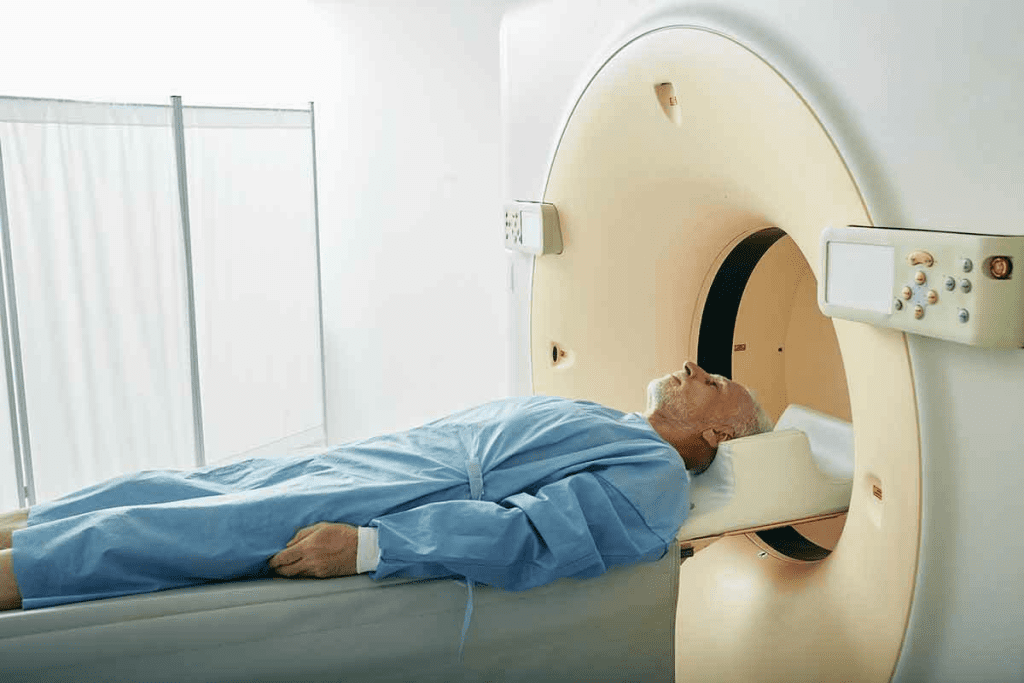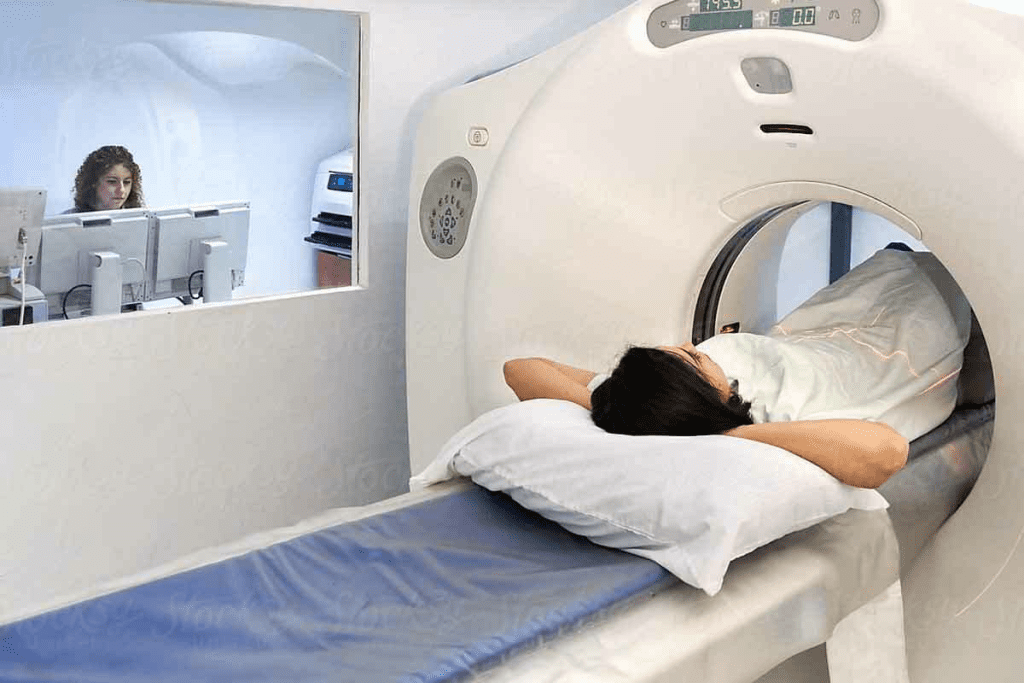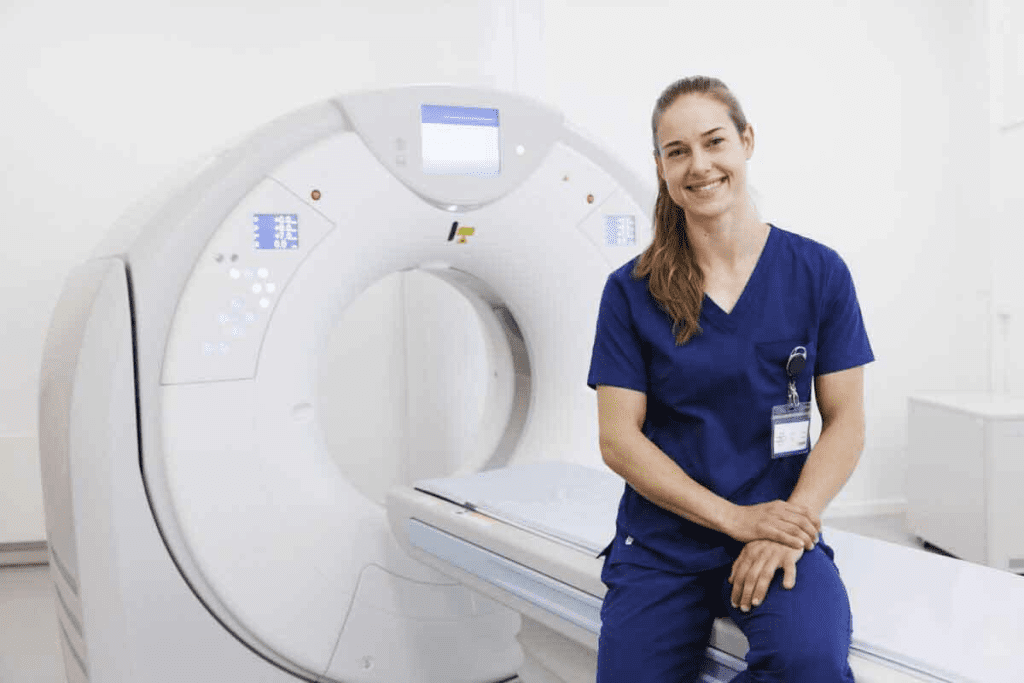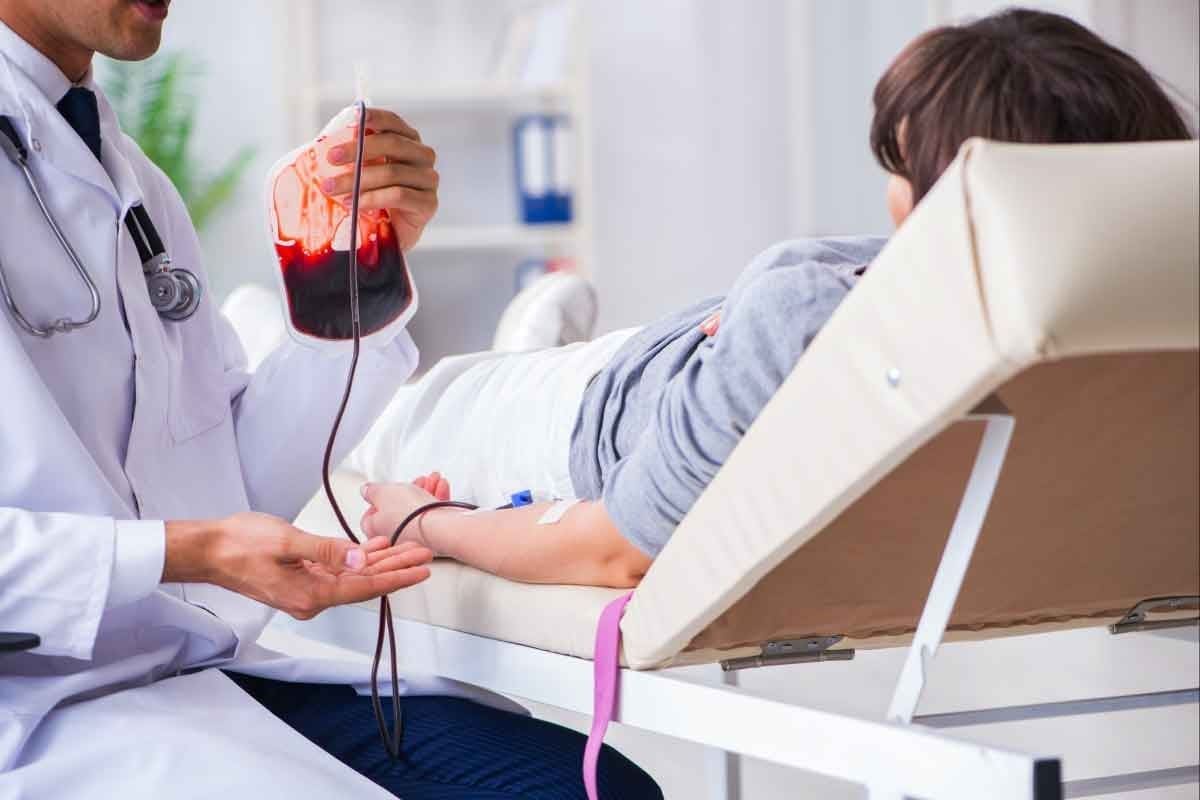Last Updated on November 27, 2025 by Bilal Hasdemir

When you have unexplained pain in your belly or think you might have inflammation or cancer, getting a clear diagnosis is key. At Liv Hospital, we use CT scans to see inside your body. They give doctors detailed pictures of your belly, helping them find problems and plan how to treat them.
A CT scan of the abdomen shows the organs, blood vessels, and bones in your belly. It gives doctors many views to help them make accurate diagnoses. CT scans can spot changes in tissue density, showing where and how bad the inflammation is. Can CT scan detect inflammation or cancer? Find the crucial facts on how this imaging technology helps diagnose these issues in the abdomen.
Key Takeaways
- CT scans provide detailed images of the abdominal cavity.
- They help identify abnormalities, such as inflammation or cancer.
- Accurate diagnosis guides treatment plans.
- Liv Hospital uses CT scans for patient-centered care.
- Advanced imaging supports optimal care decisions.
Understanding Abdominal CT Scans: Basic Principles and Technology

Abdominal CT scans have changed how we diagnose diseases. They give us detailed views of the inside of the abdomen. This helps doctors find the right treatment for many conditions.
What is a CT Scan and How Does it Work?
A CT scan uses X-rays to make detailed pictures of the body’s inside. It moves an X-ray beam around the body to take pictures from different sides. Then, it puts these pictures together to show a 3D view of the body.
This helps doctors see the organs in the abdomen. They can spot problems like inflammation and cancer.
For more details on how a CT scan works, check out RadiologyInfo.org. It’s a great place to learn about medical imaging.
Types of Abdominal CT Scans
There are different kinds of abdominal CT scans for different needs:
- Non-contrast CT: Good for finding things like kidney stones.
- Contrast-enhanced CT: Uses special agents to show certain areas better.
- CT Angiography: Shows the blood vessels in detail.
Each scan has its own benefits. Doctors choose the right one based on what they need to see.
The Role of Contrast Agents in Abdominal Imaging
Contrast agents make CT images clearer. They can be taken by mouth or through an IV. They help doctors see the difference between different parts of the abdomen.
This makes it easier to spot problems like inflammation and cancer. It helps doctors plan better treatments.
Can CT Scan Detect Inflammation in the Abdomen?

CT scans can spot inflammation in the belly by looking at tissue density differences. Inflammation changes tissue density, which CT scans can see. This lets doctors see where inflammation is happening.
Tissue Density Differences and Inflammation Visualization
CT scans measure tissue density. When tissues get inflamed, their density changes. For example, inflamed tissues might get swollen, making them less dense. Or, they might get more cells and proteins, making them denser.
These changes show up on CT scans. This helps doctors spot inflammation. It’s really helpful for finding problems like appendicitis, where the inflamed appendix looks different from other tissues.
Radiological Signs of Inflammation on CT Images
There are several signs of inflammation on CT images. These include:
- Bowel wall thickening: Inflammation makes the bowel wall thicker, which shows up on CT scans.
- Fat stranding: Inflammation changes the fat around the inflamed area, making it look streaked or dirty.
- Mucosal enhancement: The mucosa of the bowel or other organs might show more enhancement after contrast, showing inflammation.
- Abscess formation: In severe cases, inflammation can cause abscesses. These look like fluid collections with enhanced edges.
By spotting these signs, radiologists can accurately diagnose inflammation. Using contrast agents makes these signs even clearer, helping doctors make better diagnoses.
Common Inflammatory Conditions Identified Through Abdominal CT
Abdominal CT scans have changed how we diagnose conditions like appendicitis and pancreatitis. These scans give us detailed images of the abdomen. They help us spot and understand different inflammatory issues.
Appendicitis: Hallmark CT Findings
Appendicitis happens when the appendix gets inflamed. A CT scan shows an enlarged appendix, usually over 6 mm. It also shows fat stranding and inflammation around it.
Key CT findings for appendicitis include:
- Appendiceal enlargement
- Wall thickening
- Surrounding fat stranding
- Presence of an appendicolith
Pancreatitis: Acute and Chronic Presentations
Pancreatitis is inflammation of the pancreas, which can be acute or chronic. CT scans are key in diagnosing it. They show pancreatic enlargement, necrosis, and inflammation.
| Feature | Acute Pancreatitis | Chronic Pancreatitis |
| Pancreatic Size | Enlarged | Atrophied or normal |
| Necrosis | Common | Rare |
| Calcifications | Uncommon | Common |
Inflammatory Bowel Disease and Colitis
CT scans help diagnose inflammatory bowel disease (IBD), like Crohn’s and ulcerative colitis. They show how much inflammation there is and any complications or extra issues.
Diverticulitis and Other Inflammatory Conditions
Diverticulitis is inflammation of the colon’s diverticula. CT scans diagnose it. Other conditions, like epiploic appendagitis and omental infarction, are also found.
CT scans help us accurately diagnose and manage these conditions. This guides treatment and improves patient care.
How CT Scans Identify Cancerous Growths in the Abdomen
We use CT scans to find and understand cancer in the abdomen. This tool is key in modern medicine. It gives us detailed views of the abdominal area.
Tumor Detection Principles
CT scans show tumors by their size, location, and type. They use X-rays to make images of the abdomen. This helps doctors spot tumors as different shapes or spots.
Characteristics of Malignant Masses on CT
Malignant masses on CT scans have certain signs. These include irregular shapes, mixed enhancement, and growth into nearby areas. Their size and where they are can also tell us a lot.
Key features of malignant masses include:
- Irregular shapes and borders
- Heterogeneous enhancement patterns
- Invasion into surrounding tissues or organs
- Presence of necrosis or calcification
Staging Cancer with CT Imaging
CT imaging is key in cancer staging. It shows how far the cancer has spread. Knowing this helps doctors plan the best treatment.
When staging cancer, CT scans look at the tumor’s size and spread. They check for lymph node involvement and distant metastases. This info is vital for choosing the right treatment, like surgery or chemotherapy.
Types of Abdominal Cancers Detectable by CT Scanning
CT scans are key in finding many types of abdominal cancers. They help doctors plan better care and treatments. These scans give clear images of tumors and how far they’ve spread.
Colorectal Cancer
Colorectal cancer is common in the belly area. CT scans are very important in finding this cancer. They help see if the cancer has spread to other parts of the body.
Knowing how far the cancer has spread helps doctors choose the best treatment. This could be surgery, chemotherapy, or both.
Liver Cancer and Hepatic Metastases
Liver cancer can be found and checked with CT scans. These scans show the size and location of liver tumors. This info is key for planning treatment.
Pancreatic Cancer
Pancreatic cancer is hard to find and treat because it doesn’t show symptoms early. CT scans help find pancreatic tumors and see if they can be removed. They also check for cancer in other parts of the body.
Kidney and Urinary Tract Malignancies
Kidney and urinary tract cancers can be found and checked with CT scans. These scans show how big the tumor is and if it’s touching other parts. This helps doctors decide the best treatment.
In short, CT scans are very useful in finding and managing belly cancers. They give doctors clear images to plan better treatments. This helps patients get better care.
Distinguishing Between Inflammation and Cancer on CT Scans
It’s important to tell the difference between inflammation and cancer on CT scans. This helps doctors make the right diagnosis and treatment plan. CT scans can show both inflammation and cancer in the abdomen. But, we need to look at more details and do more tests to tell them apart.
Similar Presentations and Diagnostic Challenges
Inflammation and cancer can look similar on CT scans. This makes it hard to diagnose. Both can show up as abnormal tissue densities or masses. We must look closely at the CT images and consider the patient’s history and symptoms.
It’s tricky because inflammation can look like cancer, and vice versa. For example, an inflammatory lesion might look like a tumor. Or, a cancerous mass might seem like an inflammatory process. Getting the diagnosis right is key for the right treatment.
Key Differentiating Features
There are a few things that can help tell inflammation from cancer on CT scans. These include:
- The look and feel of the lesion or mass
- Signs that point to inflammation or cancer
- How the surrounding tissues and structures are affected
- The patient’s symptoms and medical history
Inflammation often shows signs like fat stranding around it. Cancer might show signs like necrosis or irregular shapes. Looking closely at these signs is key for a correct diagnosis.
When Further Testing is Necessary
Sometimes, even after looking closely, it’s hard to tell what’s going on. When this happens, we might need more tests. These could be other imaging tests like PET scans or MRI, or biopsies to get tissue samples.
We have to think about the benefits and risks of these tests. We need to consider the patient’s health and how it might affect treatment. Talking clearly with the patient about the need for more tests is very important.
The Critical Role of Contrast in Detecting Abdominal Pathologies
Contrast agents are key for making abdominal pathologies visible on CT scans. They help us see more clearly, which is vital for accurate diagnosis. This way, we can spot many different kinds of problems in the abdomen.
How Contrast Enhances Visualization
Contrast agents, given orally or through an IV, make it easier to see inside the abdomen. They show up differences in tissue density. This helps us tell apart various types of problems, like inflammation and cancer.
Using contrast agents in CT scans lets us:
- See tumors and inflammatory lesions more clearly
- Tell different types of abdominal problems apart
- Understand how severe abdominal diseases are
Oral vs. IV Contrast: Different Applications
Oral and IV contrast agents have different uses in abdominal CT scans. Oral contrast helps us see the GI tract. IV contrast is better for looking at blood vessels and solid organs.
Which contrast to use depends on what we’re looking for. For example:
- Oral contrast is good for finding issues in the GI tract, like blockages or inflammatory diseases.
- IV contrast is better for checking blood vessels, finding tumors, and seeing how far cancer has spread.
Contrast Enhancement Patterns in Inflammation vs. Cancer
The way contrast enhances can tell us a lot about what’s going on in the abdomen. Inflammation and cancer show different patterns, helping us figure out what’s happening.
For example:
- Inflammation might show a uniform enhancement.
- Cancer might show uneven enhancement, with dead tissue areas.
By looking at these patterns, we can make more accurate diagnoses.
Diagnostic Accuracy of CT Scans for Abdominal Conditions
It’s key to know how well CT scans work for finding problems in the belly. These scans are a big help because they let doctors see inside without surgery. But, how good they are can change based on a few things.
Sensitivity and Specificity for Inflammatory Conditions
CT scans are very good at spotting inflammation. For example, they can find an inflamed appendix and see any problems it might cause. Using special dyes makes these changes even clearer.
- High sensitivity for finding appendicitis and other sudden inflammation.
- Specificity is also high for seeing how bad the inflammation is and any extra issues.
But, how accurate they are can depend on when the scan is done and the quality of the machine.
Accuracy in Cancer Detection and Staging
CT scans are very important for finding and figuring out how serious belly cancers are. They can spot tumors, see how big they are, and check if they’re touching other parts or lymph nodes.
- Using special dyes helps find tumors and tell if they’re bad or not.
- Being right about how serious the cancer is helps doctors know what treatment to use and what to expect.
Factors Affecting Diagnostic Precision
There are a few things that can make CT scans less accurate for belly problems. These include:
- The quality of the CT scanner and the skill of the doctor reading the images.
- The kind of contrast agents used.
- Things about the patient, like how big they are and if they can stay very quiet during the scan.
Knowing these things helps us use CT scans better for belly problems. This can lead to better care for patients.
The CT Scan Procedure: What Patients Should Expect
Getting ready for a CT scan can make you feel nervous. But knowing what to expect can help a lot. We’ll cover how to prepare, what happens during the scan, and possible risks.
Preparation for an Abdominal CT Scan
Getting ready for your CT scan is key. You might need to fast for a few hours before, depending on your doctor’s advice. You might also drink a special liquid to make your abdomen show up better on the scan.
On the day of the scan, take off any metal items like jewelry or glasses. You might wear a gown. Tell your doctor about any medicines you’re taking, like for diabetes or kidney disease.
During the Procedure
You’ll lie on a table that slides into a big machine. The scan is quick, usually just a few minutes. You’ll need to stay very quiet and might be asked to hold your breath.
The machine is loud, but it’s not like being in a small space. If you’re uncomfortable or anxious, let us know. We’ll try to make you feel better.
Potential Risks and Side Effects
CT scans are usually safe, but there are some risks. An allergic reaction to the contrast agent is a big worry. If you have allergies, tell your doctor before the scan. A study on the National Center for Biotechnology Information says the risk is low but should be watched.
You might feel warm or taste metal during or after the contrast. These feelings usually go away quickly. But, in rare cases, the contrast can harm your kidneys, more so if you already have kidney problems.
Knowing what to expect can help you feel more at ease. If you have questions or worries, talk to your doctor. They can help and support you.
Conclusion: The Value of CT Scans in Abdominal Diagnostics
CT scans play a key role in diagnosing abdominal issues, like inflammatory diseases and cancers. They offer detailed images that are vital for accurate diagnosis and treatment planning.
CT scans have changed the way we diagnose abdominal problems. They let doctors see the abdominal cavity clearly. This has led to better patient care by catching issues early.
These scans help doctors spot complex problems in the abdomen. They guide doctors in creating specific treatment plans. So, CT scans are essential in diagnosing abdominal issues.
FAQ
Can a CT scan detect inflammation in the abdomen?
Yes, CT scans can spot inflammation in the abdomen. They do this by showing differences in tissue density and signs of inflammation.
What is the role of contrast agents in abdominal CT scans?
Contrast agents make it easier to see the inside of the abdomen. They help tell apart different conditions, like inflammation and cancer.
How do CT scans identify cancerous growths in the abdomen?
CT scans find cancer by looking for tumors. They check the tumor’s size, shape, and how it reacts to the scan.
What types of abdominal cancers can be detected using CT scans?
CT scans can find many types of abdominal cancers. This includes cancers of the colon, liver, pancreas, and kidneys.
Can CT scans distinguish between inflammation and cancer?
CT scans can give hints about the difference between inflammation and cancer. But sometimes, more tests are needed because they can look similar.
How accurate are CT scans in detecting abdominal conditions?
CT scans are very good at spotting inflammation and cancer. But, how accurate they are can depend on a few things.
What should patients expect during an abdominal CT scan?
Patients will need to prepare, possibly by getting a contrast agent. Then, they’ll lie very quietly during the scan. It’s usually quick and doesn’t hurt.
Are there any risks or side effects associated with CT scans?
CT scans use radiation, which is a risk. The contrast agents can cause allergic reactions or problems with the kidneys in some people.
Do CT scans show inflammation in the abdominal organs?
Yes, CT scans can show inflammation in organs like the pancreas, intestines, and appendix.
Can a CT scan of the abdomen detect cancer in its early stages?
CT scans can find cancerous growths. But, they might not catch cancer in its very early stages. This depends on the cancer type, location, and scan quality.
What is the difference between a CT scan with and without contrast?
A CT scan with contrast uses a special agent to make things clearer. A scan without contrast relies on natural differences in tissue density.
Reference
Abdominal and Pelvic CT: Fast, Accurate Imaging for Internal Injury and Cancer






